tires MERCEDES-BENZ C-Class SEDAN 2014 W204 Owner's Manual
[x] Cancel search | Manufacturer: MERCEDES-BENZ, Model Year: 2014, Model line: C-Class SEDAN, Model: MERCEDES-BENZ C-Class SEDAN 2014 W204Pages: 362, PDF Size: 4.8 MB
Page 5 of 362
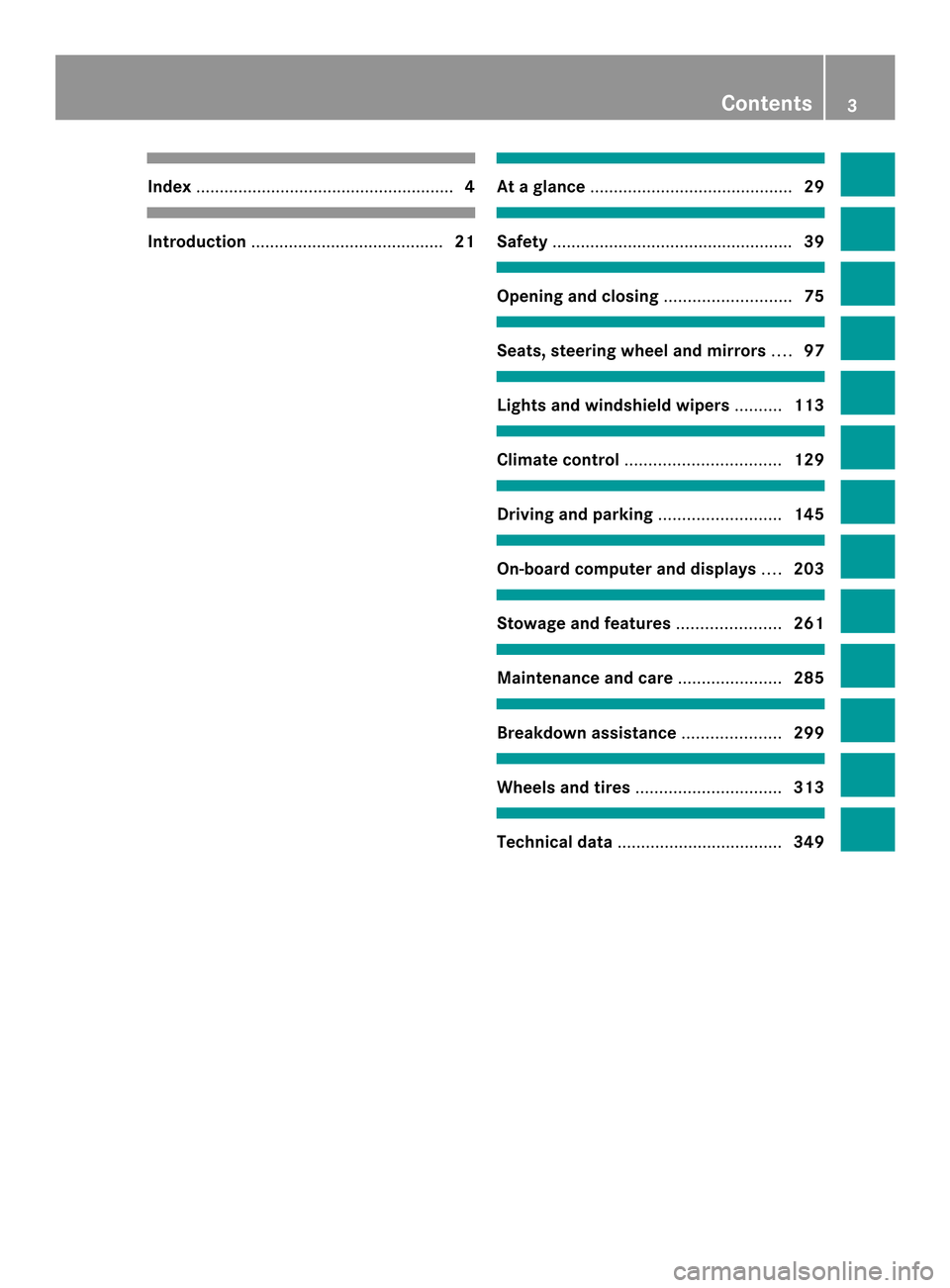
Index
....................................................... 4Introduction
......................................... 21 At
ag lance ........................................... 29 Safety
................................................... 39 Opening and closing
...........................75 Seats, steering wheel and mirrors
....97 Lights and windshield wipers
..........113 Climate control
................................. 129 Driving and parking
..........................145 On-board computer and displays
....203 Stowage and features
......................261 Maintenance and care
......................285 Breakdown assistance
.....................299 Wheels and tires
............................... 313 Technical data
................................... 349 Contents
3
Page 9 of 362
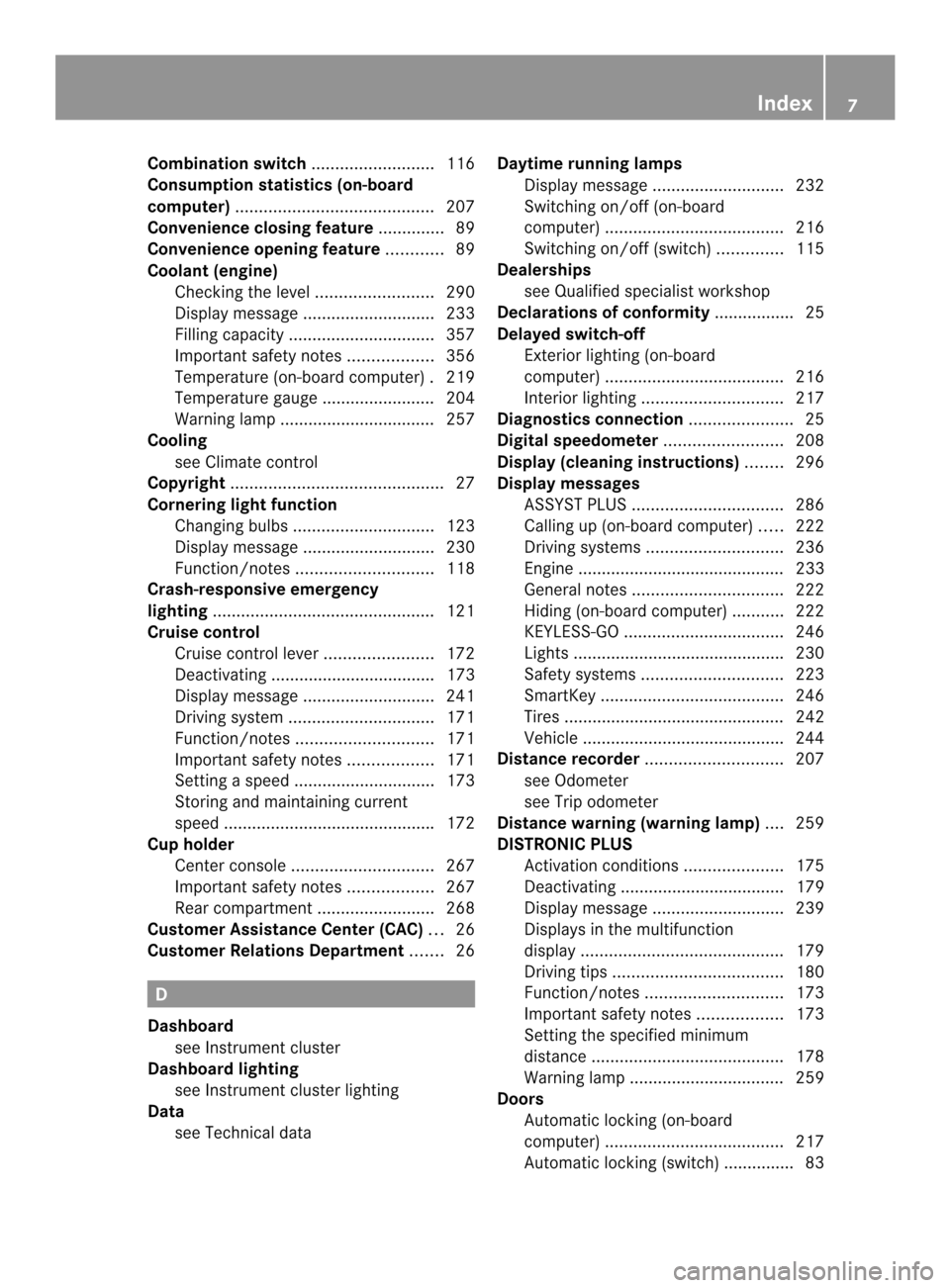
Combination switch
..........................116
Consumption statistics (on-board
computer) .......................................... 207
Convenience closing feature ..............89
Convenience opening feature ............89
Coolan t(engine)
Checkin gthe level ......................... 290
Display message ............................ 233
Filling capacity ............................... 357
Important safety notes ..................356
Temperature (on-board computer) .219
Temperature gauge ........................ 204
Warning lamp ................................. 257
Cooling
see Climate control
Copyright ............................................. 27
Cornering light function Changing bulbs .............................. 123
Display message ............................ 230
Function/notes ............................. 118
Crash-responsive emergency
lighting ............................................... 121
Cruise control Cruise control leve r....................... 172
Deactivating ................................... 173
Display message ............................ 241
Driving system ............................... 171
Function/notes ............................. 171
Important safety notes ..................171
Setting aspeed .............................. 173
Storing and maintaining current
speed ............................................ .172
Cup holder
Center console .............................. 267
Important safety notes ..................267
Rea rcompartmen t......................... 268
Customer Assistance Center (CAC) ...26
Customer Relations Department .......26 D
Dashboard see Instrument cluster
Dashboard lighting
see Instrument cluster lighting
Data
see Technical data Daytime running lamps
Display message ............................ 232
Switching on/off (on-board
computer) ...................................... 216
Switching on/off (switch) ..............115
Dealerships
see Qualified specialist workshop
Declarations of conformity ................. 25
Delaye dswitch-off
Exterio rlighting (on-board
computer )...................................... 216
Interior lighting .............................. 217
Diagnostics connection ......................25
Digital speedometer .........................208
Display (cleaning instructions) ........296
Display messages ASSYST PLUS ................................ 286
Calling up (on-board computer) .....222
Driving systems ............................. 236
Engine ............................................ 233
General notes ................................ 222
Hiding (on-board computer) ...........222
KEYLESS-GO .................................. 246
Lights ............................................ .230
Safety systems .............................. 223
SmartKey ....................................... 246
Tires ............................................... 242
Vehicle .......................................... .244
Distance recorder ............................. 207
see Odometer
see Trip odometer
Distance warning (warning lamp) ....259
DISTRONIC PLUS Activatio ncondition s..................... 175
Deactivating ................................... 179
Display message ............................ 239
Displays in the multifunction
displa y........................................... 179
Driving tips .................................... 180
Function/notes ............................. 173
Important safety notes ..................173
Setting the specified minimum
distance ......................................... 178
Warning lamp ................................. 259
Doors
Automatic locking (on-board
computer) ...................................... 217
Automatic locking (switch) .............. .83 Index
7
Page 14 of 362
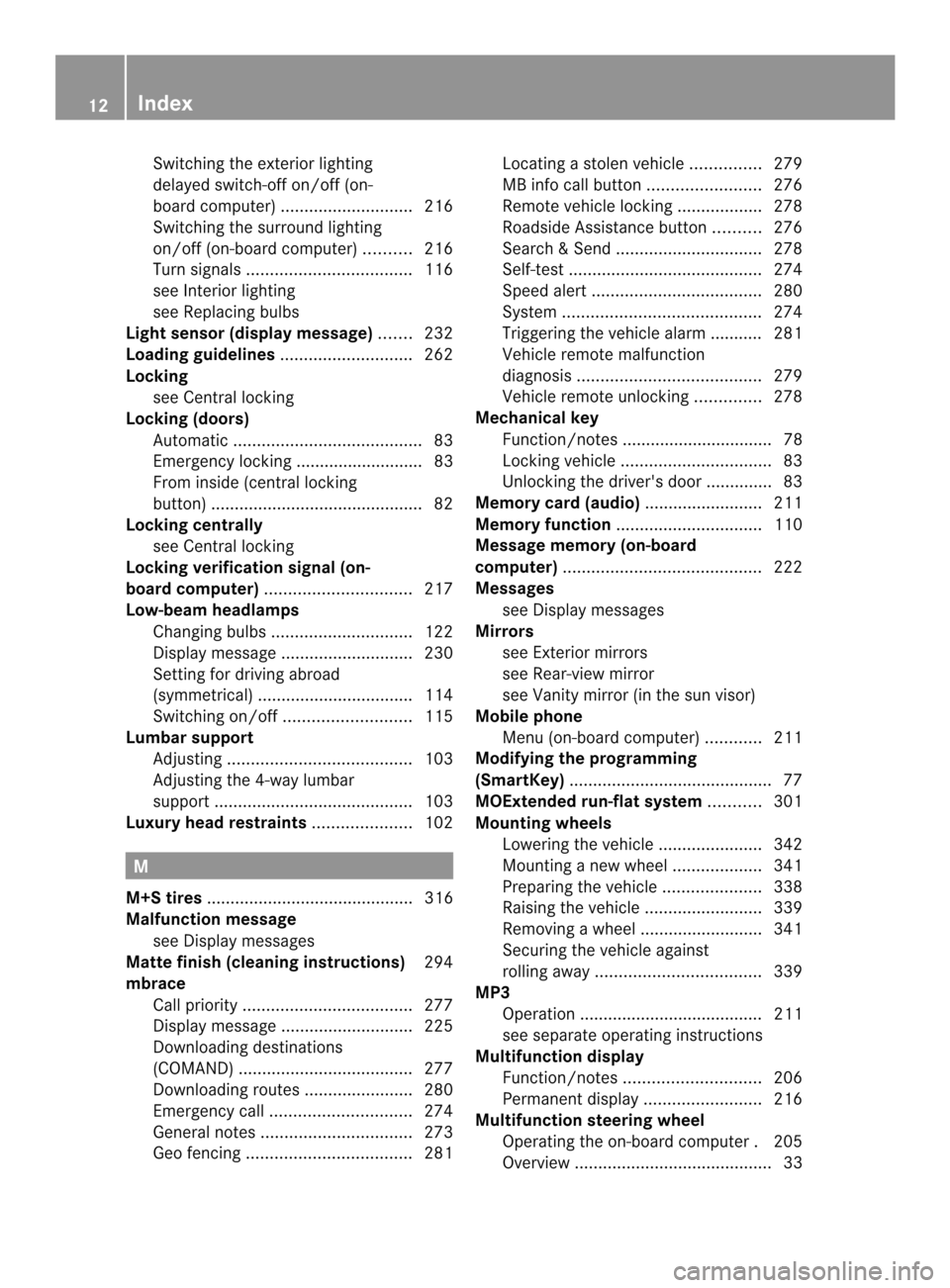
Switching the exterio
rlighting
delayed switch-off on/off (on-
board computer )............................ 216
Switching the surround lighting
on/off (on-board computer) ..........216
Turn signals ................................... 116
see Interior lighting
see Replacing bulbs
Light sensor (display message) .......232
Loading guidelines ............................262
Locking see Centra llocking
Locking (doors)
Automatic ........................................ 83
Emergency locking ........................... 83
From inside (central locking
button) ............................................. 82
Locking centrally
see Centra llocking
Locking verification signal (on-
board computer) ............................... 217
Low-beam headlamps Changing bulbs .............................. 122
Display message ............................ 230
Setting for driving abroad
(symmetrical) ................................. 114
Switching on/off ........................... 115
Lumbar support
Adjusting ....................................... 103
Adjusting the 4-way lumbar
support .......................................... 103
Luxury head restraints .....................102 M
M+S tires ............................................ 316
Malfunction message see Display messages
Matte finish (cleaning instructions) 294
mbrace Call priority .................................... 277
Display message ............................ 225
Downloading destinations
(COMAND) ..................................... 277
Downloading route s....................... 280
Emergency call .............................. 274
General notes ................................ 273
Geo fencing ................................... 281Locating
astolen vehicl e............... 279
MB info call button ........................276
Remote vehicle locking ..................278
Roadside Assistance button ..........276
Search &Send ............................... 278
Self-test ......................................... 274
Speed alert .................................... 280
System .......................................... 274
Triggering the vehicle alarm ........... 281
Vehicle remote malfunction
diagnosi s....................................... 279
Vehicle remote unlocking ..............278
Mechanical key
Function/notes ................................ 78
Locking vehicle ................................ 83
Unlocking the driver's door ..............83
Memory card (audio) .........................211
Memory function ............................... 110
Message memory (on-board
computer) .......................................... 222
Messages see Display messages
Mirrors
see Exterior mirrors
see Rear-view mirror
see Vanity mirror (in the sun visor)
Mobile phone
Menu (on-board computer) ............211
Modifying the programming
(SmartKey) ........................................... 77
MOExtended run-flat system ...........301
Mounting wheels Lowering the vehicle ......................342
Mounting anew wheel ................... 341
Preparing the vehicle .....................338
Raising the vehicle .........................339
Removing awheel .......................... 341
Securing the vehicle against
rolling away ................................... 339
MP3
Operation ....................................... 211
see separate operating instructions
Multifunction display
Function/notes ............................. 206
Permanent displa y......................... 216
Multifunction steering wheel
Operating the on-board computer .205
Overview .......................................... 3312
Index
Page 19 of 362
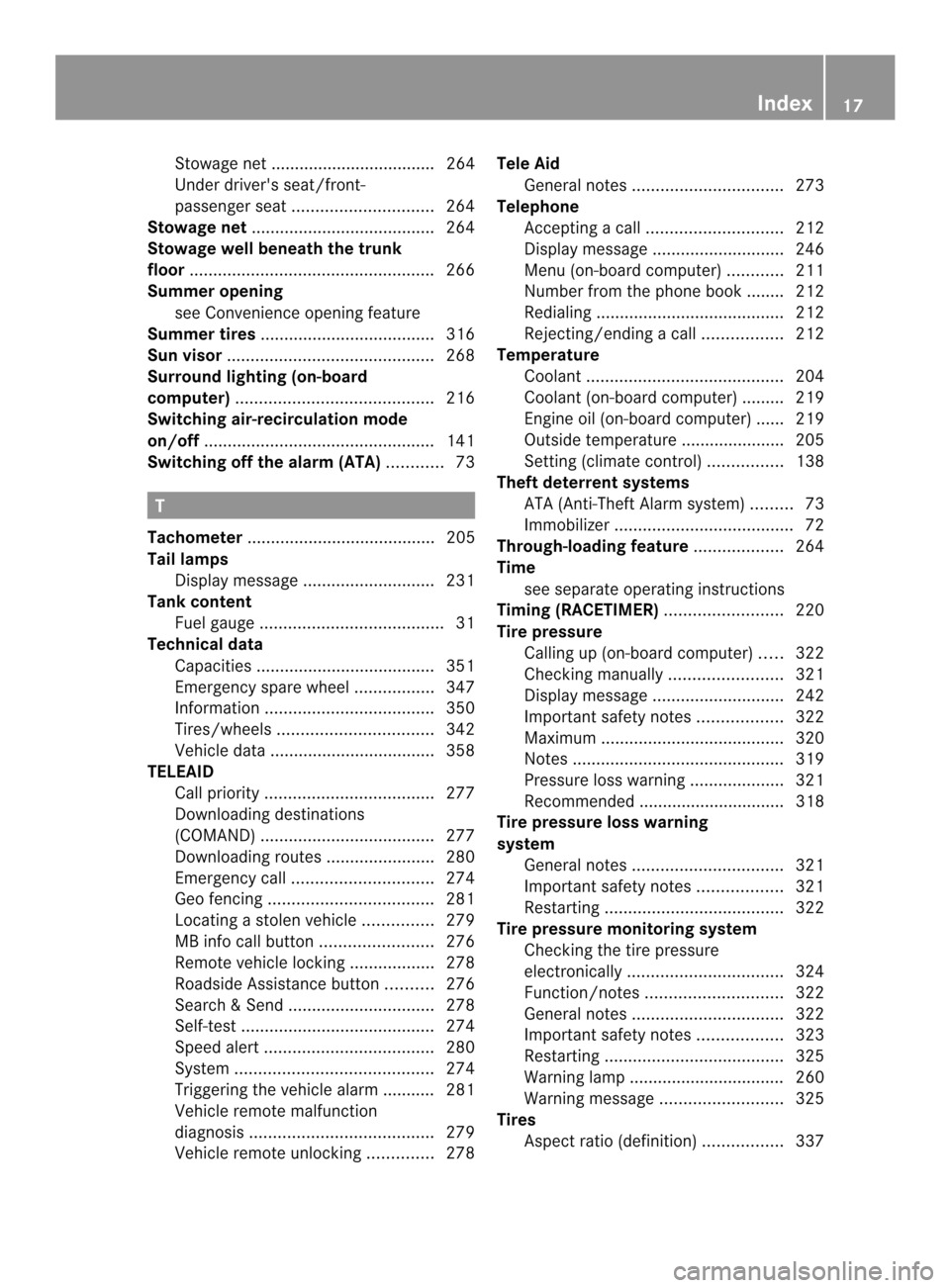
Stowage net ................................... 264
Under driver's seat/front-
passenger sea
t.............................. 264
Stowage net ....................................... 264
Stowage well beneath the trunk
floor .................................................... 266
Summer opening see Convenience opening feature
Summer tires ..................................... 316
Sun visor ............................................ 268
Surround lighting (on-board
computer) .......................................... 216
Switching air-recirculation mode
on/off ................................................. 141
Switching off the alarm (ATA) ............73 T
Tachometer ........................................ 205
Tail lamps Display message ............................ 231
Tank content
Fuel gauge ....................................... 31
Technical data
Capacities ...................................... 351
Emergency spare wheel .................347
Information .................................... 350
Tires/wheels ................................. 342
Vehicle data ................................... 358
TELEAID
Call priority .................................... 277
Downloading destinations
(COMAND) ..................................... 277
Downloading route s....................... 280
Emergency call .............................. 274
Geo fencing ................................... 281
Locating astolen vehicl e............... 279
MB info call button ........................276
Remote vehicle locking ..................278
Roadside Assistance button ..........276
Search &Send ............................... 278
Self-test ......................................... 274
Speed alert .................................... 280
System .......................................... 274
Triggering the vehicle alarm ........... 281
Vehicle remote malfunction
diagnosi s....................................... 279
Vehicle remote unlocking ..............278Tele Aid
General notes ................................ 273
Telephone
Accepting acall............................. 212
Display message ............................ 246
Menu (on-board computer) ............211
Number from the phone book ....... .212
Redialing ........................................ 212
Rejecting/ending acall................. 212
Temperature
Coolant .......................................... 204
Coolant (on-board computer) ......... 219
Engine oil (on-board computer) ...... 219
Outside temperature ..................... .205
Setting (climate control) ................138
Theft deterrent systems
ATA (Anti-Theft Alarm system) .........73
Immobilize r...................................... 72
Through-loading feature ...................264
Time see separate operating instructions
Timing (RACETIMER) .........................220
Tire pressure Calling up (on-board computer) .....322
Checking manually ........................321
Display message ............................ 242
Important safety notes ..................322
Maximum ....................................... 320
Notes ............................................. 319
Pressure loss warning ....................321
Recommended ............................... 318
Tire pressure loss warning
system
General notes ................................ 321
Important safety notes ..................321
Restarting ...................................... 322
Tire pressure monitoring system
Checking the tire pressure
electronically ................................. 324
Function/notes ............................. 322
General notes ................................ 322
Important safety notes ..................323
Restarting ...................................... 325
Warning lamp ................................. 260
Warning message .......................... 325
Tires
Aspect ratio (definition) .................337 Index
17
Page 20 of 362
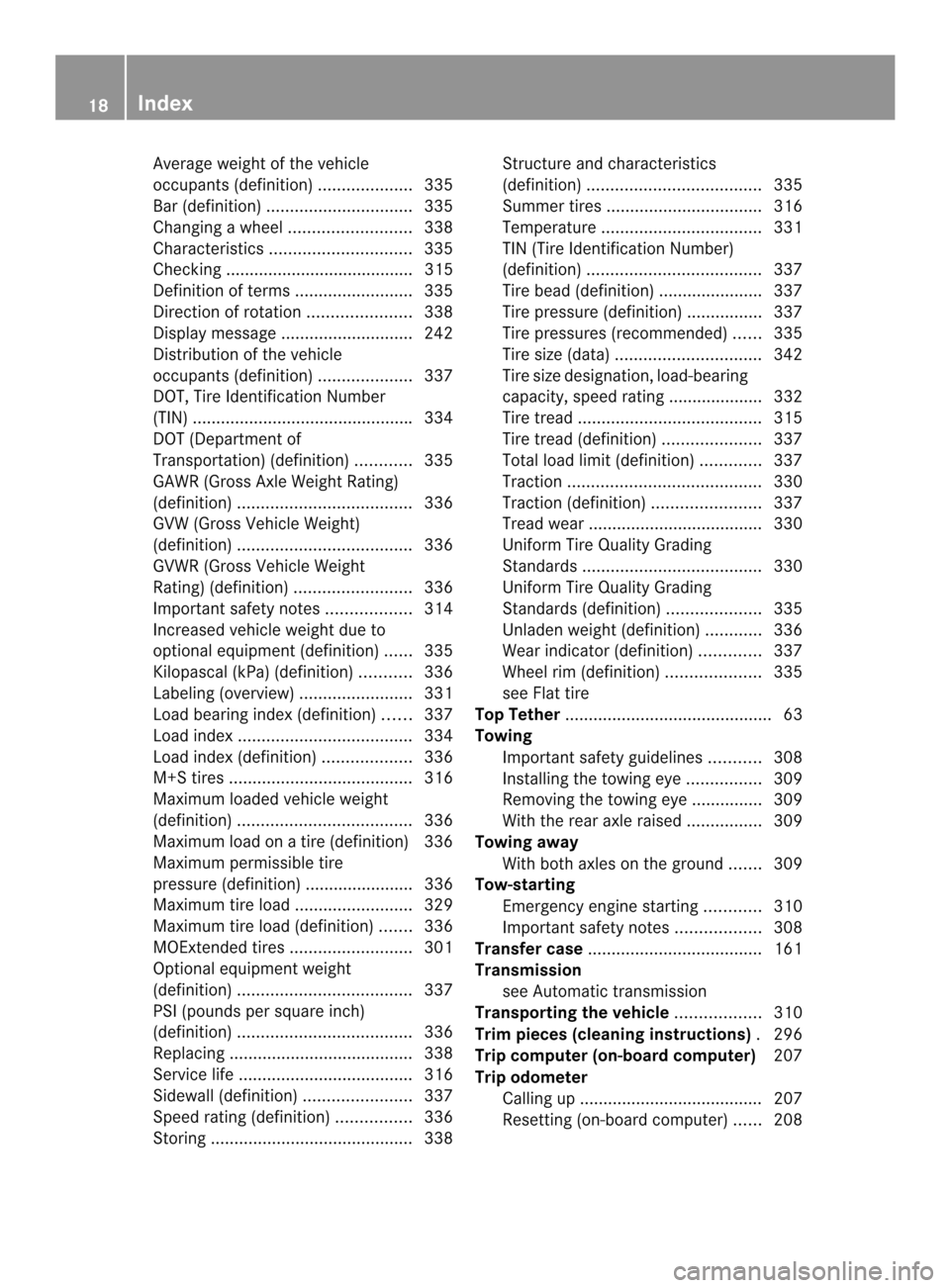
Average weight of the vehicle
occupants (definition)
....................335
Bar (definition) ............................... 335
Changing awheel .......................... 338
Characteristics .............................. 335
Checking ........................................ 315
Definition of terms .........................335
Direction of rotatio n...................... 338
Display message ............................ 242
Distributio nofthe vehicle
occupants (definition) ....................337
DOT, Tire Identification Number
(TIN) .............................................. .334
DOT (Department of
Transportation) (definition) ............335
GAWR (Gross Axle Weight Rating)
(definition) ..................................... 336
GVW (Gross Vehicle Weight)
(definition) ..................................... 336
GVWR (Gross Vehicle Weight
Rating) (definition) .........................336
Important safety notes ..................314
Increased vehicle weight due to
optional equipment (definition) ......335
Kilopascal (kPa) (definition) ...........336
Labeling (overview )........................ 331
Load bearing index (definition) ......337
Load index ..................................... 334
Load index (definition) ...................336
M+S tires ....................................... 316
Maximum loaded vehicle weight
(definition) ..................................... 336
Maximum load on a tire (definition) 336
Maximum permissible tire
pressure (definition) ....................... 336
Maximum tire loa d......................... 329
Maximum tire load (definition) .......336
MOExtended tires ..........................301
Optional equipment weight
(definition) ..................................... 337
PSI (pounds per square inch)
(definition) ..................................... 336
Replacing ....................................... 338
Service life ..................................... 316
Sidewall (definition) .......................337
Speed rating (definition) ................336
Storing ........................................... 338Structure and characteristics
(definition)
..................................... 335
Summer tires ................................. 316
Temperature .................................. 331
TIN (Tire Identification Number)
(definition) ..................................... 337
Tire bea d(definition) ...................... 337
Tire pressure (definition) ................337
Tire pressures (recommended )...... 335
Tire size (data) ............................... 342
Tire size designation, load-bearing
capacity, speed rating .................... 332
Tire tread ....................................... 315
Tire tread (definition) .....................337
Total load limit (definition) .............337
Traction ......................................... 330
Traction (definition) .......................337
Trea dwear ..................................... 330
Uniform Tire Quality Grading
Standard s...................................... 330
Uniform Tire Quality Grading
Standard s(definition) .................... 335
Unladen weight (definition) ............336
Wea rindicato r(definition) .............337
Whee lrim (definition ).................... 335
see Flat tire
Top Tether ............................................ 63
Towing Important safety guidelines ...........308
Installing the towing eye ................309
Removing the towing eye. ..............309
With the rear axle raised ................309
Towing away
With both axles on the ground .......309
Tow-starting
Emergency engine starting ............310
Important safety notes ..................308
Transfer case ..................................... 161
Transmission see Automatic transmission
Transporting the vehicle ..................310
Trim pieces (cleaning instructions) .296
Trip computer (on-board computer) 207
Trip odometer Calling up ....................................... 207
Resetting (on-board computer) ......208 18
Index
Page 22 of 362
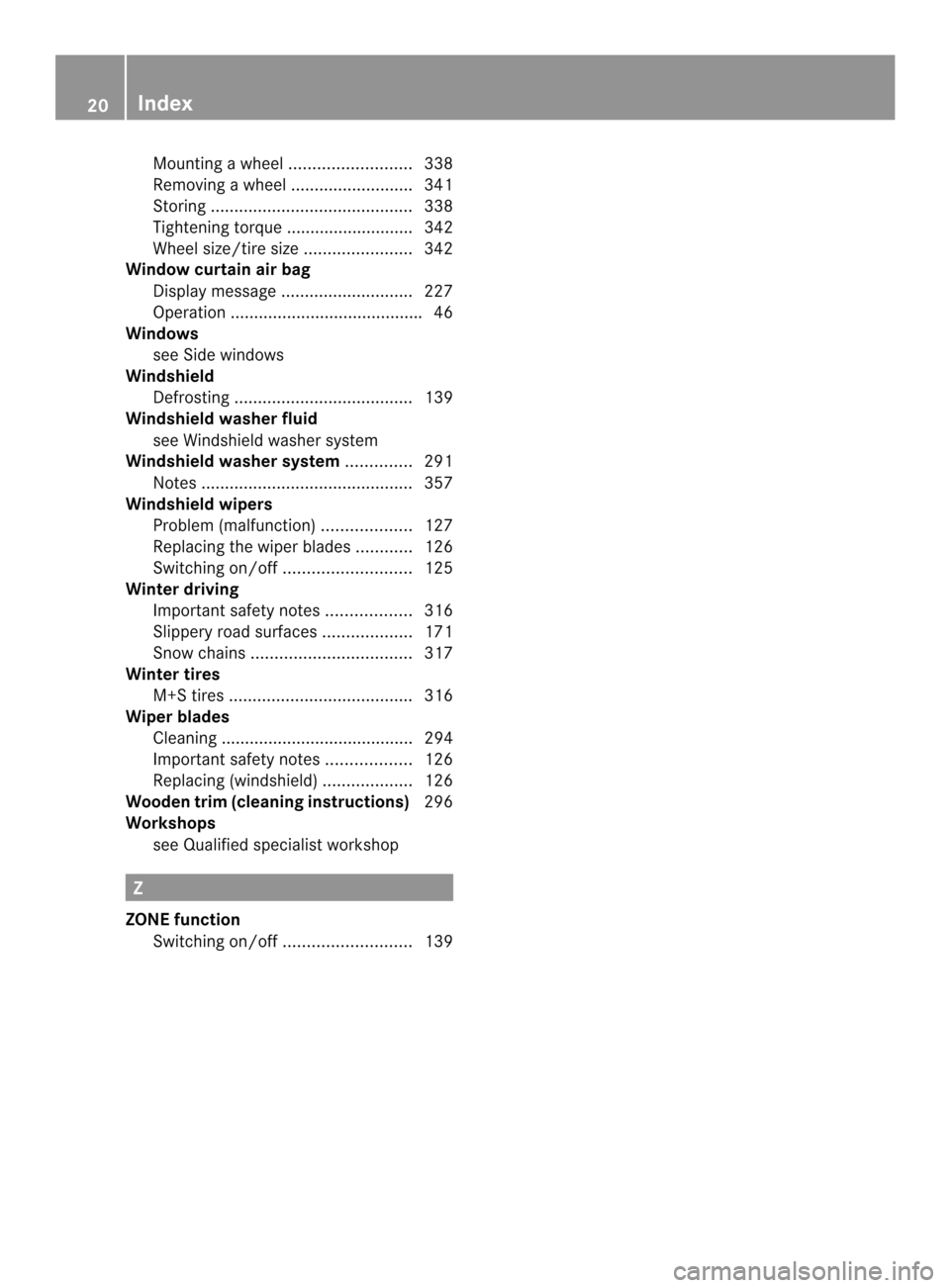
Mounting
awheel .......................... 338
Removing awheel .......................... 341
Storing ........................................... 338
Tightening torque ........................... 342
Whee lsize/tir esize ....................... 342
Window curtain air bag
Display message ............................ 227
Operation ........................................ .46
Windows
see Side windows
Windshield
Defrosting ...................................... 139
Windshiel dwasher fluid
see Windshield washer system
Windshield washer system ..............291
Notes ............................................. 357
Windshiel dwipers
Problem (malfunction) ...................127
Replacing the wiper blades ............126
Switching on/off ........................... 125
Winte rdriving
Important safety note s.................. 316
Slippery road surfaces ...................171
Snow chains .................................. 317
Winter tires
M+S tires ....................................... 316
Wiper blades
Cleaning ......................................... 294
Important safety notes ..................126
Replacing (windshield )................... 126
Wooden trim (cleaning instructions) 296
Workshops see Qualified specialist workshop Z
ZONE function Switching on/off ........................... 13920
Index
Page 24 of 362
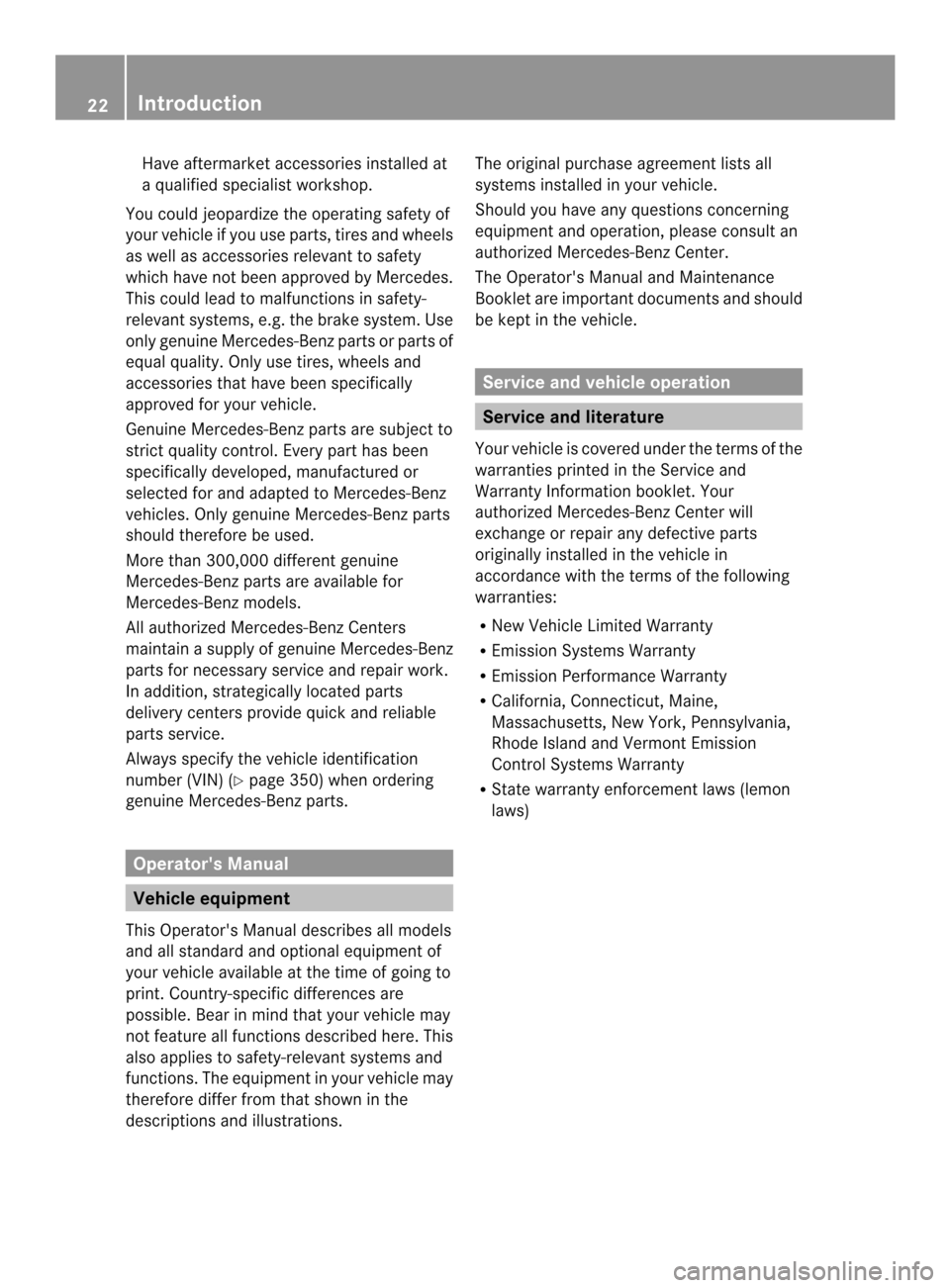
Have aftermarke
taccessories installed at
a qualified specialist workshop.
You could jeopardize the operating safety of
your vehicle if you use parts, tires and wheels
as well as accessories relevant to safety
which have not bee napproved by Mercedes.
This could lead to malfunctions in safety-
relevant systems, e.g. the brake system .Use
only genuine Mercedes-Benz parts or parts of
equal quality. Only use tires, wheels and
accessories that have been specifically
approved for your vehicle.
Genuine Mercedes-Benz parts are subject to
strict quality control. Every part has been
specifically developed, manufactured or
selected for and adapted to Mercedes-Benz
vehicles. Only genuine Mercedes-Benz parts
should therefore be used.
More than 300,000 different genuine
Mercedes-Benz parts are available for
Mercedes-Benz models.
All authorized Mercedes-Benz Centers
maintain a supply of genuine Mercedes-Benz
parts for necessary service and repair work.
In addition, strategically located parts
delivery centers provide quick and reliable
parts service.
Always specify the vehicle identification
number (VIN) (Y page 350) when ordering
genuine Mercedes-Benz parts. Operator's Manual
Vehicle equipment
This Operator's Manual describes all models
and all standard and optional equipment of
your vehicle available at the time of going to
print. Country-specific differences are
possible.B ear in mind that your vehicle may
not feature all functions described here. This
also applies to safety-relevant systems and
functions. The equipment in your vehicle may
therefore differ from that shown in the
descriptions and illustrations. The original purchase agreement lists all
systems installed in your vehicle.
Should you have any questions concerning
equipment and operation, please consult an
authorized Mercedes-BenzC
enter.
The Operator's Manual and Maintenance
Booklet are important documents and should
be kept in the vehicle. Service and vehicle operation
Service and literature
Your vehicle is covered under the terms of the
warranties printed in the Service and
Warranty Information booklet. Your
authorized Mercedes-BenzC enter will
exchange or repair any defective parts
originally installed in the vehicle in
accordance with the term softhe following
warranties:
R New Vehicle Limited Warranty
R Emission Systems Warranty
R Emission Performance Warranty
R California, Connecticut, Maine,
Massachusetts, New York, Pennsylvania,
Rhode Island and Vermont Emission
Control Systems Warranty
R State warranty enforcement laws (lemon
laws) 22
Introduction
Page 27 of 362
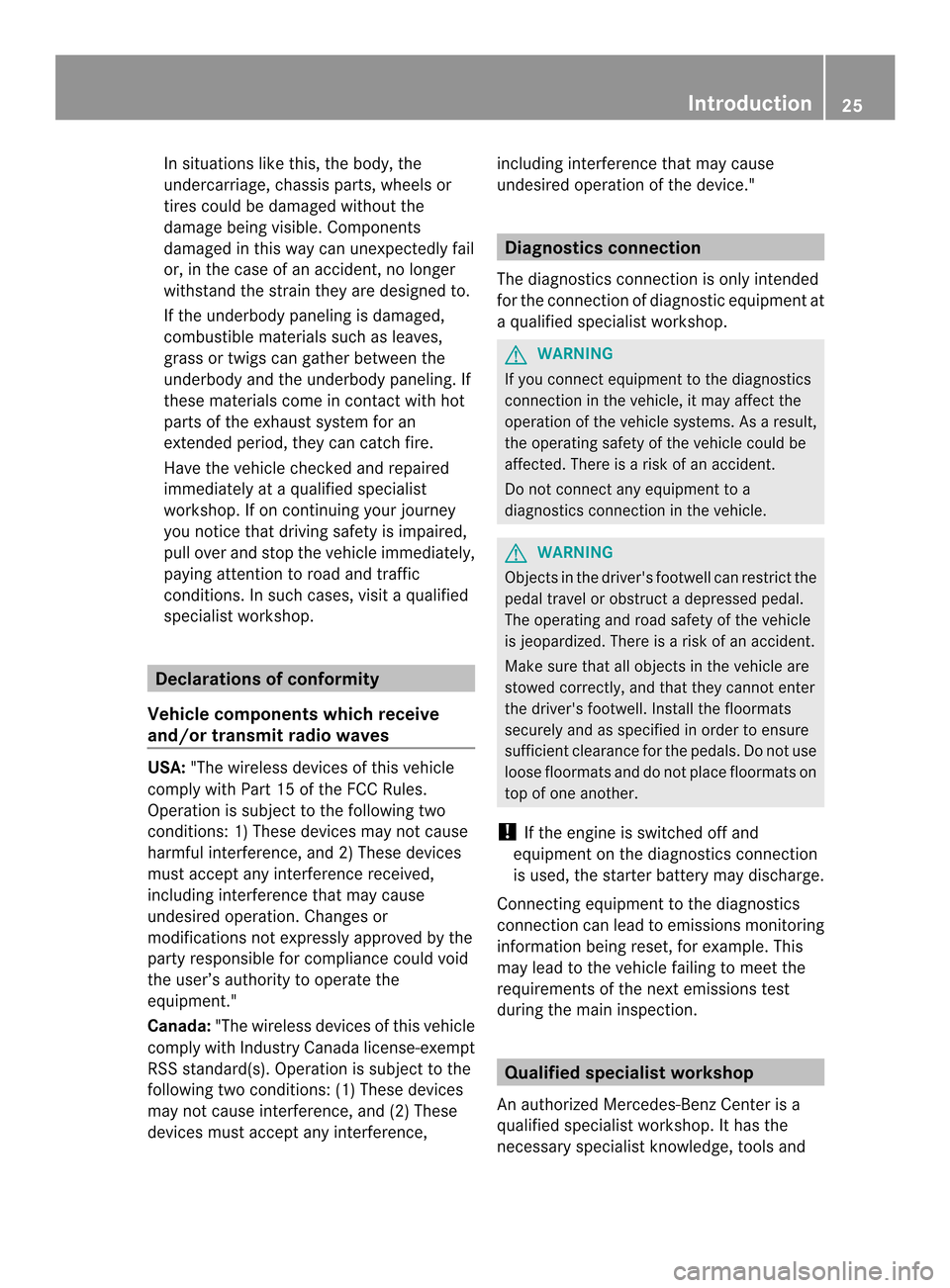
In situations like this, the body, the
undercarriage, chassis parts, wheels or
tires could be damaged withou tthe
damage being visible. Components
damaged in this way can unexpectedly fail
or, in the case of an accident, no longer
withstand the strain they are designed to.
If the underbody paneling is damaged,
combustible materials such as leaves,
grass or twigs can gather between the
underbody and the underbody paneling. If
these materials come in contact with hot
parts of the exhaust system for an
extended period, they can catch fire.
Have the vehicle checked and repaired
immediately at a qualified specialist
workshop. If on continuing your journey
you notice that driving safety is impaired,
pull over and stop the vehicle immediately,
paying attention to road and traffic
conditions. In such cases, visit a qualified
specialist workshop. Declarations of conformity
Vehicle components which receive
and/or transmit radio waves USA:
"The wireless devices of this vehicle
comply with Part 15 of the FCC Rules.
Operation is subject to the following two
conditions: 1) These devices may not cause
harmful interference, and 2) These devices
must accept any interference received,
including interference that may cause
undesired operation. Changes or
modifications not expressly approved by the
party responsible for compliance could void
the user’s authority to operate the
equipment."
Canada: "The wireless devices of this vehicle
comply with Industry Canada license-exempt
RSS standard(s). Operation is subject to the
following two conditions: (1) These devices
may not cause interference, and (2) These
devices must accept any interference, including interference that may cause
undesired operation of the device." Diagnostics connection
The diagnostics connection is only intended
for the connection of diagnostic equipment at
a qualified specialist workshop. G
WARNING
If you connect equipment to the diagnostics
connection in the vehicle, it may affect the
operation of the vehicle systems. As a result,
the operating safety of the vehicle could be
affected. There is a risk of an accident.
Do not connect any equipment to a
diagnostics connection in the vehicle. G
WARNING
Objects in the driver's footwell can restrict the
pedal travel or obstruct adepressed pedal.
The operating and road safety of the vehicle
is jeopardized. There is a risk of an accident.
Make sure that all objects in the vehicle are
stowed correctly, and that they cannot enter
the driver's footwell. Install the floormats
securely and as specified in order to ensure
sufficien tclearance for the pedals. Do not use
loose floormats and do not place floormats on
top of one another.
! If the engine is switched off and
equipmen tonthe diagnostics connection
is used, the starter battery may discharge.
Connecting equipment to the diagnostics
connection can lead to emissions monitoring
information being reset, for example. This
may lead to the vehicle failing to meet the
requirements of the next emissions test
during the main inspection. Qualified specialist workshop
An authorized Mercedes-Ben zCenter is a
qualified specialist workshop. It has the
necessary specialist knowledge, tools and Introduction
25 Z
Page 67 of 362
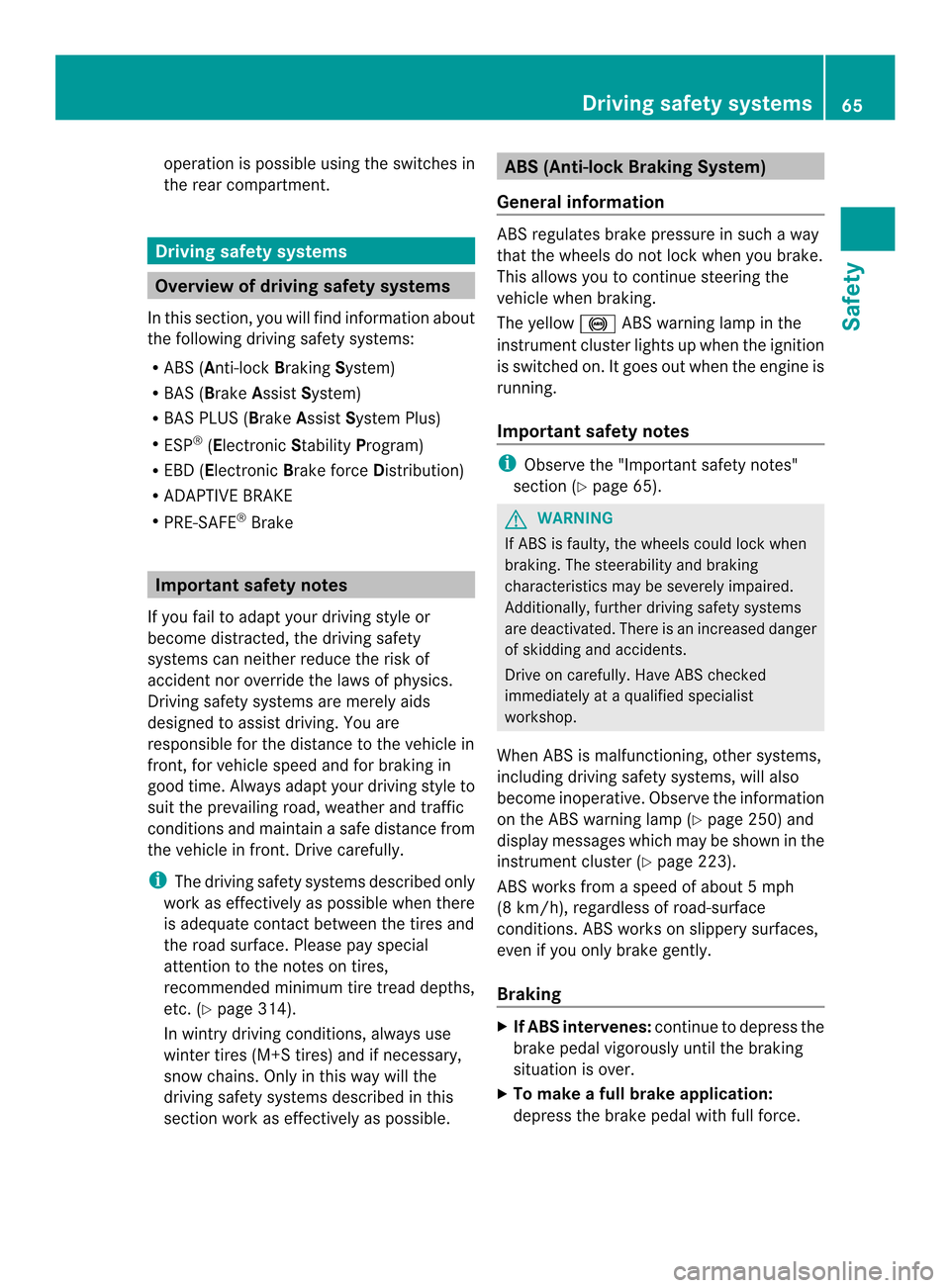
operation is possible using the switches in
the rear compartment. Driving safety systems
Overview of driving safety systems
In this section, you will find information about
the following driving safety systems:
R ABS (Anti-lock BrakingSystem)
R BAS (Brake AssistSystem)
R BAS PLUS ( BrakeAssist System Plus)
R ESP ®
(Electronic StabilityProgram)
R EBD ( Electronic Brake force Distribution)
R ADAPTIVE BRAKE
R PRE-SAFE ®
Brake Important safety notes
If you fail to adapt your driving style or
become distracted, the driving safety
systems can neither reduce the risk of
accident nor override the laws of physics.
Driving safety systems are merely aids
designed to assist driving. You are
responsible for the distance to the vehicle in
front, for vehicle speed and for braking in
good time. Always adapt your driving style to
suit the prevailing road, weather and traffic
conditions and maintain asafe distance from
the vehicle in front. Drive carefully.
i The driving safety systems described only
work as effectively as possible when there
is adequate contact between the tires and
the road surface. Please pay special
attention to the note son tires,
recommended minimu mtire tread depths,
etc. (Y page 314).
In wintry driving conditions, always use
winter tires (M+S tires) and if necessary,
snow chains. Only in this way will the
driving safety systems described in this
section work as effectively as possible. ABS (Anti-lock Braking System)
General information AB
Sr egulates brake pressure in such a way
that the wheels do not lock when you brake.
This allows you to continue steering the
vehicle when braking.
The yellow 0018ABS warning lamp in the
instrument cluster lights up when the ignition
is switched on. It goes out when the engine is
running.
Important safety notes i
Observe the "Important safety notes"
section (Y page 65). G
WARNING
If ABS is faulty, the wheels could lock when
braking. The steerability and braking
characteristics may be severely impaired.
Additionally, further driving safety systems
are deactivated. There is an increased danger
of skidding and accidents.
Drive on carefully. Have ABS checked
immediately at a qualified specialist
workshop.
When ABSi s malfunctioning, other systems,
including driving safety systems, will also
become inoperative. Observe the information
on the ABS warning lamp (Y page 250) and
display messages which may be shown in the
instrument cluster (Y page 223).
ABS works from a speed of about 5 mph
(8 km/h), regardless of road-surface
conditions. ABS works on slippery surfaces,
even if you only brake gently.
Braking X
If ABS intervenes: continue to depress the
brake pedal vigorously until the braking
situation is over.
X To make a full brake application:
depress the brake pedal with full force. Driving safety systems
65Safety Z
Page 69 of 362
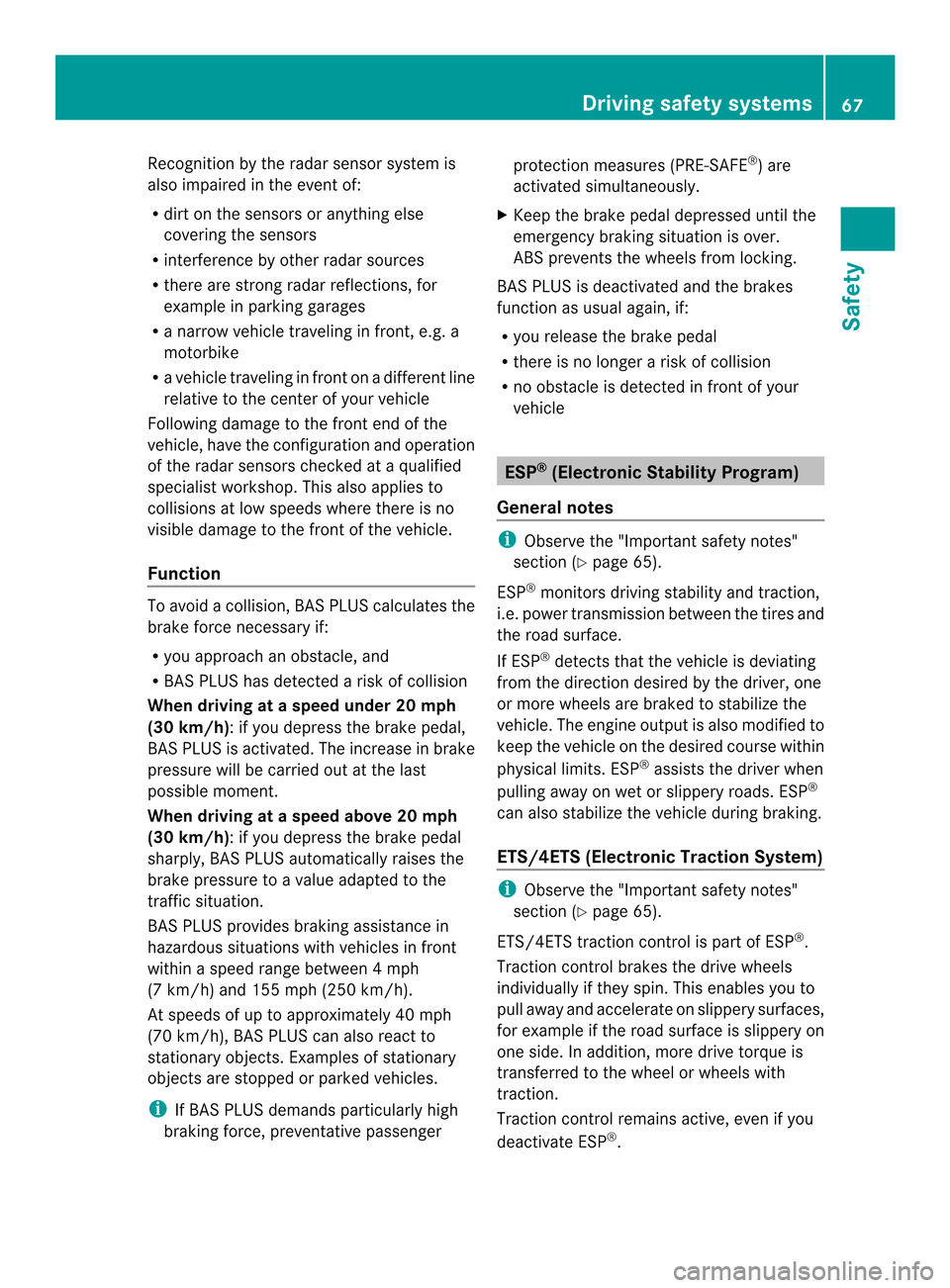
Recognition by the radar sensor system is
also impaired in the event of:
R dir tont he sensors or anything else
covering the sensors
R interference by other radar sources
R there are strong radar reflections, for
example in parking garages
R a narrow vehicle traveling in front, e.g. a
motorbike
R a vehicle traveling in front on a different line
relative to the center of your vehicle
Following damage to the front end of the
vehicle, have the configuration and operation
of the radar sensors checked at a qualified
specialist workshop. This also applies to
collisions at low speeds where there is no
visible damage to the front of the vehicle.
Function To avoid a collision, BAS PLUS calculates the
brake force necessary if:
R you approach an obstacle, and
R BAS PLUS has detected arisk of collision
When driving at a speed under 20 mph
(30 km/h):ify ou depress the brake pedal,
BAS PLUS is activated. The increase in brake
pressure will be carried out at the last
possible moment.
When driving at a speed above 20 mph
(30 km/h) :ifyou depress the brake pedal
sharply, BAS PLUS automatically raises the
brake pressure to a value adapted to the
traffic situation.
BAS PLUS provides braking assistance in
hazardous situations with vehicles in front
within a speed range between 4mph
(7 km/h) and 155 mph (250 km/ h).
At speeds of up to approximately 40 mph
(70 km/h), BAS PLUS can also react to
stationary objects. Examples of stationary
objects are stopped or parked vehicles.
i If BAS PLUS demands particularly high
braking force, preventative passenger protection measures (PRE-SAFE
®
) are
activated simultaneously.
X Keep the brake pedal depressed until the
emergency braking situatio nis over.
ABS prevents the wheels from locking.
BAS PLUS is deactivated and the brakes
function as usual again, if:
R you release the brake pedal
R there is no longer a risk of collision
R no obstacle is detected in front of your
vehicle ESP
®
(Electronic Stability Program)
General notes i
Observe the "Important safety notes"
section (Y page 65).
ESP ®
monitors driving stability and traction,
i.e. power transmission between the tires and
the road surface.
If ESP ®
detects that the vehicle is deviating
from the direction desired by the driver, one
or more wheels are braked to stabilize the
vehicle. The engine output is also modified to
keep the vehicle on the desired course within
physical limits. ESP ®
assists the driver when
pulling away on wet or slippery roads. ESP ®
can also stabilize the vehicle during braking.
ETS/4ETS (Electronic Traction System) i
Observe the "Important safety notes"
section (Y page 65).
ETS/4ETS traction control is part of ESP ®
.
Traction control brakes the drive wheels
individually if they spin. This enables you to
pull away and accelerate on slippery surfaces,
for example if the road surface is slippery on
one side. In addition, more drive torque is
transferred to the wheel or wheels with
traction.
Traction control remains active, even if you
deactivate ESP ®
. Driving safety systems
67Safety Z